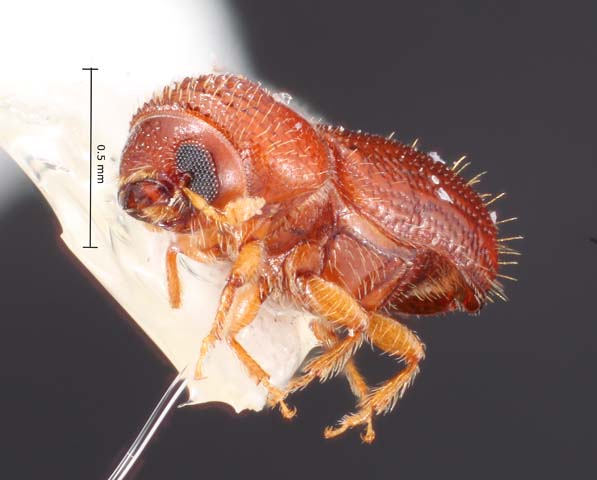Pityophthorus consimilis LeConte 1878


 Images: Displaying 1 to 8 of 26
Images: Displaying 1 to 8 of 26 




 Pityophthorus consimilis (female)
Pityophthorus consimilis (female) |
 Pityophthorus consimilis (female)
Pityophthorus consimilis (female) |
 Pityophthorus consimilis (male)
Pityophthorus consimilis (male) |
 Pityophthorus consimilis (male)
Pityophthorus consimilis (male) |
 Pityophthorus consimilis (male)
Pityophthorus consimilis (male) |
 Pityophthorus consimilis (male)
Pityophthorus consimilis (male) |
 Pityophthorus consimilis (male)
Pityophthorus consimilis (male) |
 Pityophthorus consimilis (male)
Pityophthorus consimilis (male) |
| Next > |

Pityophthorus consimilis (male) (by TH Atkinson, Biodiversity Center, University of Texas at Austin).
 Summary of Information
Summary of Information





SYNONYMY
- Pityophthorus consimilis LeConte 1878. Proc. Amer. Philos. Soc. 17: 622
- Pityophthorus granulatus Swaine 1917. Dom. Canada Dept. Agr. Tech. Bull. 14(1): 28
- Pityophthorus nudus Swaine 1917. Dom. Can. Dept. Agric. Entomol. Br. Tech. Bull. 14: 30
DISTRIBUTION.
Numbers in parentheses after each geographic unit are the number of distinct collection events in the database for that unit. For exotic species generally only countries are listed for localities outside the New World. For further information on published sources of distribution, check the REFERENCES section.
There are no distribution records in the database
HOSTS
Numbers in parentheses after each host family, genus, or collection method are the number of distinct collection events in the database for that host or method.
REFERENCES
The following are important recent monographs, catalogs, and supplements to catalogs that refer to this species. The specific page on which the reference is made is shown in pink at the end of the reference. In the case of Wood (1982) and Wood & Bright (1992) clicking on the reference page will link to a digital version of the work in question.
- Bright, D.E. 1981. A taxonomic monograph of the genus Pityophthorus Eichhoff in North and Central America (Coleoptera: Scolytidae). Entomol. Soc. Can. Mem. 118:1-378. [283]. (data capture complete)
- Wood, S.L. 1982. The bark and ambrosia beetles of North and Central America (Coleoptera: Scolytidae), a taxonomic monograph. Great Basin Nat. Mem. 6:1-1356. [1104]. (data capture complete)
- Wood, S.L., Bright,D.E. 1992. A catalog of Scolytidae and Platypodidae (Coleoptera), Part 2. Taxonomic Index. Great Basin Nat. Mem. 13:1-1553 (vol. A, B). [991]
The following are references from which host and distribution data have been input into the database. If one of the above monographs or catalogs also appears in this list, it means that most relevant collection event data have been included.
- . . .
- Atkinson, T.H.; Rabaglia,R.J.; Peck,S.J.; Foltz,J.L. 1991. New records of Scolytidae and Platypodidae from the United States and Bahamas. Coleopterists Bull. 45(2): 152-164.
- Atkinson, T.H.; Riley, E.G. 2013. Atlas and Checklist of the bark and ambrosia beetles of Texas and Oklahoma (Curculionidae: Scolytinae and Platypodinae). Insecta Mundi 292: 1-46.
- Blackman, M.W. 1922. Mississippi Bark Beetles. Miss. Agric. Exp. Sta. Tech. Bull. 11: 1-130.
- Bright, D.E. 1981. A taxonomic monograph of the genus Pityophthorus Eichhoff in North and Central America (Coleoptera: Scolytidae). Entomol. Soc. Can. Mem. 118: 1-378.
- Deyrup, M.A. 1981. Annotated list of Indiana Scolytidae (Coleoptera). Great Lakes Entomol. 14: 1-9.
- Dodge H.R. 1938. The bark beetles of Minnesota (Coleoptera: Scolytidae). Univ. Minn. Agric. Exp. Sta. Tech. Bull. 132.
- EDRR 2011. USFS Early Detection Rapid Response Database. http://www.fs.fed.us/invasivespecies/earlydetection.shtml/.
- Popa, V.; Morneau, L.; Piche, C.; Deshaies, A.; Bauce, E.; Guertin, C. 2013. Occurrence of species of the genus Pityophthorus Eichhoff (Coleoptera, Curculionidae, Scolytinae) in the province of Quebec, Canada. Zookeys 348: 97-124.
- Weber, B.C., MacPherson, J.E. 1991. Seasonal Flight Patterns Of Scolytidae (Coleoptera) In Black-Walnut Plantations In North-Carolina And Illinois. Coleopterists Bull. 45(1): 45-56.
- Wood, S.L. 1982. The bark and ambrosia beetles of North and Central America (Coleoptera: Scolytidae), a taxonomic monograph. Great Basin Nat. Mem. 6: 1-1356.
 Distribution Map
Distribution Map





Maps automatically open at the center of the plotted points and the scale is set to encompass all map points. Maps can be resized (scale bar at upper left) and the center moved (place cursor over map and drag) to see other parts of the distribution of the species. Clicking on a map marker will pull up collection event data and a literature citation if present. If any errors are found, please refer to the "series code" which is a unique identifier for a database record in any communications). Coordinates have not been entered for all collection records. Localities outside the New World are not plotted, even though they are listed in the distribution summary and in the table of records.
There are no distribution records in the database
 Collection Records
Collection Records





There are no distribution records in the database
Return to top of page
